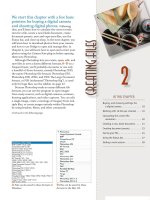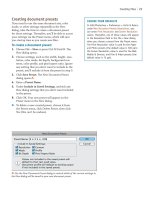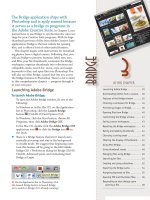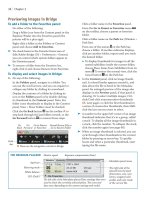Sử dụng photoshop cs5 part 6 pdf
Bạn đang xem bản rút gọn của tài liệu. Xem và tải ngay bản đầy đủ của tài liệu tại đây (746.36 KB, 7 trang )
ptg
36 Chapter 3
Previewing images in Bridge
To add a folder to the Favorites panel:
Do either of the following:
Drag a folder icon from the Content panel or the
Explorer/Finder into the Favorites panel (the
pointer will be a plus sign).
Right-click a folder in the Folders or Content
panel and choose Add to Favorites.
➤ Via check boxes in the Favorite Items area of
Edit/Adobe Bridge CS5 > Preferences > General,
you can control which system folders appear in
the Favorites panel.
➤ To remove a folder from the Favorites list,
right-click it and choose Remove from Favorites.
To display and select images in Bridge:
1. Do any of the following:
In the Folders panel, navigate to a folder. You
can use the scroll arrows, and you can expand or
collapse any folder by clicking its arrowhead.
Display the contents of a folder by clicking its
icon in the Folders panel or by double-clicking
its thumbnail in the Content panel. Note: For
folder icons thumbnails to display in the Content
panel, View > Show Folders must be checked.
Click the Go Back button on the toolbar
A
to
step back through the last folders viewed, or the
Go Forward button to reverse those steps.
Click a folder name in the Favorites panel.
From the Go to Parent or Favorites menu
on the toolbar, choose a parent or favorites
folder.
Click a folder name on the Path bar (Window >
Path Bar).
From one of the menus on the Path bar,
choose a folder. If another submenu displays,
click yet another folder; repeat until you reach
the desired folder.
➤ To display thumbnails for images in all the
nested subfolders inside the current folder,
choose Show Items from Subfolders from its
menu. To restore the normal view, click the
Cancel button on the Path bar.
2.
In the Content panel, click an image thumb-
nail. A colored border appears around it, and
data about the le is listed in the Metadata
panel. An enlarged preview of the image also
displays in the Preview panel, if that panel is
showing. Or to select multiple images, Ctrl-
click/Cmd-click nonconsecutive thumbnails
(
A
, next page); or click the rst thumbnail in
a series of consecutive thumbnails, then Shift-
click the last one you want to select.
➤ A number in the upper left corner of an image
thumbnail indicates that it’s in a group, called
a stack. To display all the image thumbnails in
a stack, click the number. To collapse the stack,
click the number again (see page 48).
➤ When an image thumbnail is selected, you can
cycle through other thumbnails in the current
folder by pressing an arrow key. To quickly
locate and select a particular thumbnail, start
typing the le name.
Go
Back
Go
Forward
Go to Parent
or Favorites
Reveal Recent File or
Go to Recent Folder
A
e s e a r e t h e n a v i g a t i o n c o n t r o l s i n B r i d g e .
Path
bar
Aperture
Metering mode
White balance
ISO (Duh!)
e l e f t s i d e o f t h e M e t a d a t a p l a c a r d l i s t s s e t t i n g s t h a t w e r e
used to shoot the currently selected photo. e icons and
data vary depending on the camera settings and model.
Shutter speed Exposure compensation (bias)
Metadata panel menu
e r i g h t s i d e o f t h e
placard lists the pixel
dimensions, size, reso-
lution, assigned color
prole, and color mode
of the current le.
THE METADATA PLACARD
ptg
Bridge 37
You can control whether thumbnails and the preview
render quickly but at low resolution, or slower and
color-managed at high resolution.
To choose quality options for the
thumbnails and previews:
From the Options for umbnail Quality and
Preview Generation menu on the Bridge
toolbar, choose a preference for the thumbnail
quality:
Prefer Embedded (Faster) displays low-
resolution thumbnails and is useful when you
need to display many images quickly.
High Quality on Demand displays high-
resolution, color-managed thumbnails and pre-
views for selected thumbnails (generated from
the source les) and low-resolution previews
for unselected ones. is is a good compromise
between the two other options.
Always High Quality, the default setting, dis-
plays high-resolution thumbnails and previews,
whether the thumbnails are selected or not.
Rendering is the slowest with this option.
➤ For lower quality but faster previewing, click the
Browse Quickly by Preferring Embedded Images
button on the Bridge Path bar; this enables
the Prefer Embedded (Faster) option. Click the
button again to return to the current setting on
the Options for umbnail Quality and Preview
Generation menu.
➤ e Generate 100% Previews option saves
actual-size JPEG versions of thumbnails to disk
so Bridge can generate higher-quality previews
when the loupe is used or when images are dis-
played at 100% view in the Full Screen Preview
or in Slideshow mode. Since this option uses
a lot of disk space, we recommend keeping it
unchecked.
A
Ctrl-click/Cmd-click to select multiple consecutive or nonconsecutive image thumbnails.
ptg
38 Chapter 3
To compare two or more image previews:
1. In Bridge, click or choose the Filmstrip or
Preview workspace.
2.
In the Content panel, Ctrl-click/Cmd-click up
to nine thumbnails.
A
Large versions of those
thumbnails will display in the Preview panel.
3.
Optional: Ctrl-click/Cmd-click an unselected
thumbnail in the Content panel to add it to the
Preview panel, or do the same for a selected
thumbnail to remove it from the Preview panel.
To display a full-screen image preview:
1. Press the Spacebar to display a full-screen pre-
view of the currently selected thumbnail and
hide the Bridge window temporarily.
2.
To zoom in or out, press + or – or use the scroll
wheel on your mouse (you can drag the magni-
ed preview). If desired, press the right arrow
key to cycle through other thumbnails in the
same folder.
3.
To redisplay the Bridge window, press the
Spacebar or Esc.
To inspect image details with an onscreen
loupe:
1. To make the loupe appear, click an image in the
Preview panel or click the frontmost image in
Review mode (see the next page).
B
Note: If the loupe doesn’t appear, it’s because
the Ctrl-Click/Cmd-Click Opens the Loupe When
Previewing or Reviewing option is checked in
Edit/Adobe Bridge CS5 > Preferences > General
(for Bridge). If this is the case, Ctrl-click/
Cmd-click the image to make the loupe appear.
2.
Click the area to be examined. By default, pixels
display in the loupe at 100% view (the zoom
level is listed below the preview). Press + to
zoom in on the loupe display (up to 800%) or
press – to zoom out, or use the scroll wheel on
your mouse. To examine a dierent area, click
that area or drag the loupe to it.
3.
Optional: If you’re previewing two images using
two loupes, you can Ctrl-drag/Cmd-drag either
loupe to move them simultaneously.
4.
Click the loupe to remove it.
A
We Ctrl/Cmd clicked two image thumbnails to display them in the Preview panel, then clicked a preview to display the loupe.
B
You can inspect
small details in
a preview by
using the loupe.
ptg
Bridge 39
When selected thumbnails are put into Review
mode, the Bridge window is hidden to make room
for a very large preview on a black background, and
you can cycle through the images as if they’re on
a carousel.
To preview images in Review mode:
1. Do one of the following:
Open a folder of images.
Alt-click/Option-click a thumbnail stack.
Select ve or more image thumbnails
(Ctrl/Cmd or Shift-click them).
2.
Press Ctrl-B/Cmd-B (or from the Rene menu
at the top of the Bridge window, choose
Review Mode). e Bridge window is hidden
temporarily, and the images display on a black
background.
A
3. To rotate the carousel, do any of the following:
Drag any image preview to the left or right.
Click one of the smaller previews to bring it to
the forefront.
Click (and keep clicking) the Go Forward or
Go Backward button in the lower left corner,
or press the left or right arrow key.
4. To examine the frontmost (enlarged) image
with a loupe, click it. Drag the loupe to move it.
Click the loupe again to remove it.
5. To rate the frontmost thumbnail, right-click
it and choose a star rating or a label from the
context menu. To view a list of keyboard short-
cuts onscreen, press H.
6. To take the frontmost image out of the
carousel, click the down-pointing arrow in
the lower left corner, or drag the image to the
bottom of your screen. is won’t delete the
actual le.
➤ You can pare down a selection of images
this way before grouping them as a stack
(see pages 48–49) or as a collection (see
pages 52–53).
7. To exit Review mode, press Esc or click the
in the lower right corner.
8. Click any image thumbnail to deselect the rest.
A
We Ctrl/Cmd clicked seven image thumbnails, then pressed Ctrl-B/Cmd-B to view them in Review mode.
ptg
40 Chapter 3
Opening files from Bridge
You can open as many les into Photoshop as the
currently available RAM and scratch disk space on
your computer allow.
Note: To open a raw, JPEG, or TIFF digital photo
into Camera Raw (to apply corrections before open-
ing the les into Photoshop), see pages 62–63.
To open files from Bridge into Photoshop:
1. In the Content panel, display the thumbnail for
the image(s) to be opened.
2.
Do either of the following:
Double-click an image thumbnail.
Click an image thumbnail or select multiple
thumbnails, then double-click one of them or
press Ctrl-O/Cmd-O.
Photoshop will launch, if it isn’t already run-
ning, and the image(s) will appear onscreen.
If any alert dialogs appear, see page 58.
➤ If a photo has been opened in Camera Raw
and settings were applied to it in that dialog,
the icon displays in the top right corner of
its thumbnail. If you’re condent about the
photo’s current Camera Raw settings and are
ready to open it into Photoshop, Shift-double-
click it.
➤ To locate a le in Explorer/Finder, right-click
its thumbnail in Bridge and choose Reveal in
Explorer/Reveal in Finder from the context
menu. e folder that the le resides in will
open in a window in Explorer/Finder and the
le icon will be selected.
➤ By default, the Bridge window stays open after
you use it to open a le. To minimize/close
the Bridge window as you open a le, hold
down Alt/Option while double-clicking the le
thumbnail.
➤ To open an image into Photoshop from Review
mode, right-click it and choose Open from the
context menu.
GETTING TO PHOTOSHOP QUICKLY
If Photoshop was the last Creative Suite application
open, you can go to it quickly from Bridge by click-
ing the Return to Adobe Photoshop button on the
toolbar.
★
Photoshop will launch, if it isn’t already
running.
ALAS, THE POOR OPEN COMMAND
➤ With Bridge now the best vehicle for opening
fi l e s , t h e O p e n c o m m a n d i s r e l e g a t e d t o t h i s s i d e b a r .
To use the Open command in Photoshop, choose
File > Open (Ctrl-O/Cmd-O). In Windows, choose Files
of Type: All Formats; in the Mac OS, choose Enable:
All Readable Documents. Locate and click the desired
fi l e n a m e , t h e n c l i c k O p e n .
➤ Another way to open a fi le is by double-clicking
its fi l e i c o n in Explorer/Finder. Photoshop will also be
launched, if it’s not already running.
To reopen a recently opened file:
To reopen a le that was recently opened and
then closed, choose the le name in one of
these locations:
In Bridge, choose from the Open Recent File
menu
on the right side of the Path bar.
In Bridge or Photoshop, choose from the File >
Open Recent submenu.
In Bridge, from the Reveal Recent File or Go
to Recent Folder menu, choose Adobe
Photoshop > Recent Adobe Photoshop Files,
then click the thumbnail for a le to open it.
To redisplay an “actual” folder when you return
to Bridge, click the Go Back arrow or a
Favorites folder.
In Photoshop, on the toolbar of the Mini
Bridge panel, from the Go to Parent, Recent
Items, or Favorites menu, choose Recent
Folders > Recent Adobe Photoshop Files,
then click the thumbnail for a le to open it. To
redisplay an “actual” folder in Mini Bridge, click
the Go Back arrow. ★
ptg
Bridge 41
B
Moving the vertical bar for the right pane to the left
widens the Preview, Metadata, and Keywords panels.
A
Moving the horizontal bar upward shortens the
Favorites and Folder panels and lengthens the Filter,
Collections, and Export panel group.
Customizing the Bridge window
To display or hide the panels:
On the Window menu, check which panels you
want to show or hide.
➤ To quickly hide (and then show) the side panes,
press Tab or double-click the dark vertical bar
between the side and middle panes.
➤ To display just the Content panel in a compact
window, click the Switch to Compact Mode
button in the upper right corner of the
Bridge window. Click it again to restore the
full window.
To configure the Bridge panes and panels
manually:
Do any of the following:
To make a panel or panel group taller or
shorter, drag its horizontal gripper bar upward
or downward.
A
To make a whole pane wider or narrower, drag
its vertical gripper bar horizontally;
B
the
adjacent pane will resize accordingly.
To minimize a panel to just a tab (or to restore
its former size), double-click its tab. (is
doesn’t work for all panels.)
To move a panel into a dierent group, drag
the panel tab, and release the mouse when
the blue drop zone border appears around the
desired group.
To display a panel as a separate group, drag its
tab between two panels, and release the mouse
when the horizontal blue drop zone line appears.
To resize the image thumbnails:
At the bottom of the Bridge window, drag
the u m b n a i l S i z e slider
C
or click the
Smaller umbnail Size button or Larger
u m b n a i l S i z e button.
➤ To display only full thumbnails, with grid lines
between them, click the Lock umbnail Grid
button at the bottom of the Bridge window.
With this option on, no shuing of thumbnails
will occur if you resize the Content panel.
C
Use the umbnail Size slider at the bottom of the Bridge window to resize your image thumbnails.
ptg
42 Chapter 3
2.
To control which categories of metadata display
below or next to the image thumbnails when the
View Content as umbnails option is chosen,
go to Edit/Adobe Bridge CS5 > Preferences >
u m b n a i l s , t h e n s e l e c t f r o m a n y o r a l l o f t h e
Details: Show menus. For example, to display
exposure settings, you would choose Exposure.
➤ When the View Content as umbnails option
is chosen, you can toggle the display of data on
and o by pressing Ctrl-T/Cmd-T.
1.
In the lower right corner of the Bridge window,
click a View Content button:
A
View Content
as umbnails (minimal le data), View
Content as Details (more le data),
B
or View
Content as List (small icons with columns of
data).
➤ With View Content as List chosen, you can
change the column order by dragging any
column header to the left or right.
View
Content
as List
View
Content as
u m b n a i l s
View Content
as Details
A
e V i e w C o n t e n t b u t t o n s
control the display of metadata
in the Content panel.
B
With the View Content as Details button clicked, metadata displays next to the le thumbnails.
METADATA IN THE TOOL TIPS
If Show Tooltips is checked
in Edit/Adobe Bridge CS5
Preferences > Thumbnails and
you rest the pointer on an
image thumbnail, the tool tip
will list the metadata for that
image. You can turn this feature
off if it becomes annoying.
To control how metadata is displayed in the Content panel:









